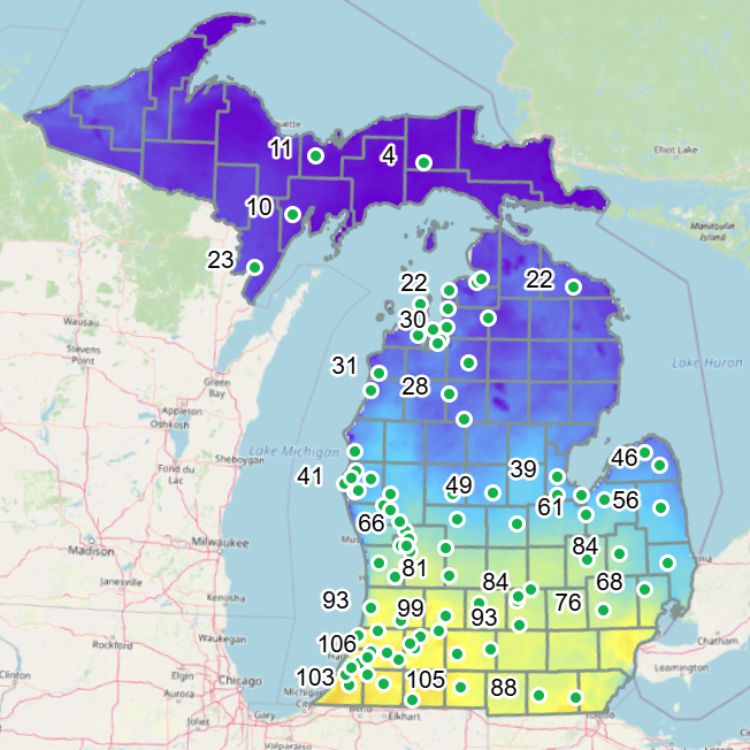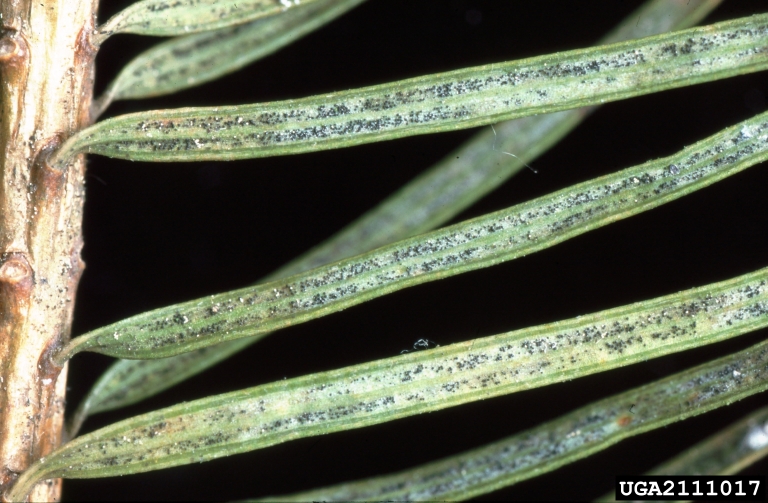Christmas tree field report – April 14, 2025
Updates on pest management, scouting and farm notes from Christmas tree producers across Michigan.

Growing degree day accumulations across the state (Photo 1) range from near 100 in southern Lower Peninsula to around 10 in the northern Upper Peninsula. Compared to normal, these values are one to two weeks ahead of normal for the majority of the southern Lower Peninsula, whereas the northern Lower Peninsula is near normal and most of the Upper Peninsula is one to two weeks behind normal. Keep in mind that pest development is driven by heat accumulation, and specific treatment models and treatment windows have been established for controlling pests. The “Michigan Christmas Tree Pest Management Guide” from Michigan State University Extension provides available control products and timings based on growing degree day predictions.
Insect and disease updates
Some Christmas tree species, such as Douglas fir and Colorado blue spruce, are highly susceptible to needlecast diseases. New trees showing signs of disease have recently been reported (Photo 2). Trees that are now showing signs of disease were infected last spring and summer and are just now becoming symptomatic. To confirm disease, use a hand lens and check for rows of black dots on the undersides of needles (Photo 3). These are the fruiting bodies that will result in future infections. You can treat needlecast diseases as trees break bud and start new vegetative growth. The general rule of thumb is to apply your preventive fungicide program at 0.5 to 2 inches of new growth. Subsequent application treatments and application intervals are based on disease pressure.


Remember, these treatments are to prevent new needles from becoming infected. Treatments are not curative, and needles infected in past years will still show disease symptoms this spring. Other cultural practices to consider include maintaining good air circulation to decrease time needles remain wet by reducing weed pressure, increasing tree spacing, or utilizing basal pruning. With subsequent years of healthy needles, infected trees can greatly improve in appearance.
Farm news and notes
Spring planting is well underway across the state and will continue for the next month. Avoid common planting mistakes by reviewing the “Christmas Tree Planting Guide (E3481),” available in English and Spanish.
Spring preemergent herbicides are being applied and can continue until budbreak. Check “Weed Control in Christmas Trees (E3237)” for a detailed list of many herbicide products. Michigan State University (MSU) Extension recommends rotating between different herbicide modes of action in subsequent years to prevent a weed species from becoming resistant to a specific class of herbicides.
The Environmental Protection Agency (EPA) has implemented a new bulletin system called Bulletins Live! Two to better protect endangered species. For more information on this process, check out MSU Extension’s Bulletins Live! Two website. It is encouraged to document (print out or save) a copy of the EPA Bulletins Live! Two webpage showing your farm’s location and if any pesticides are currently restricted in use.
Keep in mind this system is designed to be dynamic and is often updated with new pesticides. You can check and document the Bulletins Live! Two system a maximum of six months prior to your pesticide usage.
Want to request a farm visit? Contact Bill Lindberg at lindbe35@msu.edu or 616-438-2738 for assistance on Christmas tree related problems.



 Print
Print Email
Email

